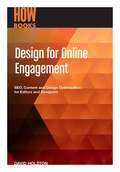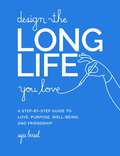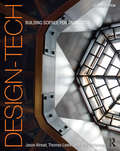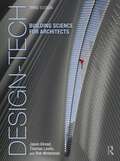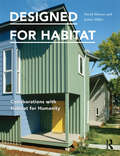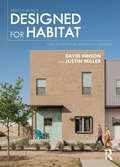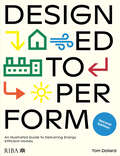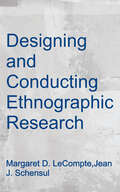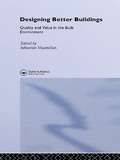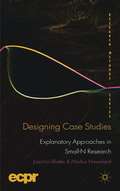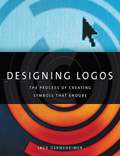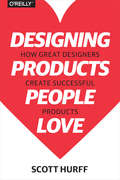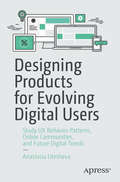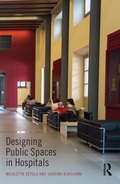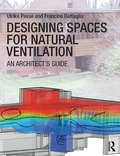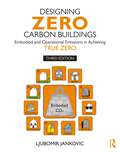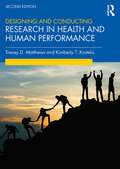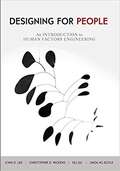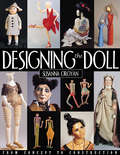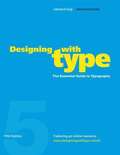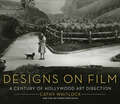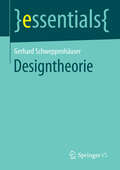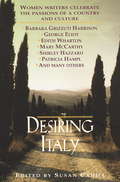- Table View
- List View
Design for Online Engagement
by David HolstonThe world changes on a daily basis. People's needs change, political, technical and social thinking changes, and your site will need to change to reflect the world around it. On a daily basis you need to be aware of any number of elements including strategy, brand, search, content, design, code, and measurement. And you need to be constantly checking to make sure you're on course. The Web never sleeps, and neither should your site.
Design for Online Engagement: SEO, Content and Design Optimization for Editors and Designers
by David HolstonThe world changes on a daily basis. People's needs change, political, technical and social thinking changes, and your site will need to change to reflect the world around it. On a daily basis you need to be aware of any number of elements including strategy, brand, search, content, design, code, and measurement. And you need to be constantly checking to make sure you’re on course. The Web never sleeps, and neither should your site.
Design the Long Life You Love: A Step-by-Step Guide to Love, Purpose, Well-Being, and Friendship
by Ayse BirselDesign a long life full of love, purpose, well-being, and friendship, at any age, using the creative tools of award-winning product designer, author, and world's #1 life coach Ayse Birsel.What does it mean to craft the life you want, as you grow older? For industrial designer and author Ayse Birsel, the answer draws on key principles of design—like optimism, empathy, collaboration, open-mindedness, and holistic thinking—as well as the experiences of older people on the pioneering frontiers of long life. Longer life is a thrilling, modern opportunity, and like so many parts of life it needs to be thoughtfully designed. Thinking about a long life is very exciting indeed. It&’s also a new phenomenon. Fifty years ago, living into one&’s seventies was considered the mark of a long life. Today, seventy feels young, eighty feels normal, and ninety is within reach. Birsel believes this new horizon of life is as important and exciting as the invention of moving pictures. Or that of automobiles, or even space travel. Her point is, when a change this big happens, innovation follows.This book is for everyone who is interested in defining their long life, using design thinking tools. It&’s an interactive book with exercises that will help you think creatively by asking you to visualize your life. It is full of insights learned from wise people who have lived the longest. It is organized into the four themes of Love, Purpose, Well-Being, and Friendship, and contains insights that will help you love better, find purpose, practice well-being, and make friends. Drawing on Birsel&’s year-long codesign research with older people, Design the Long Life You Love offers readers of all ages—from those in their twenties and thirties just starting out, to those in mid-life looking for a change, to those in later life who are the experts for us all—thought-provoking questions, exercises for self-exploration, and interviews with innovative entrepreneurs and thought-leaders to guide them on their own journeys of crafting the next phase of life. Focusing on four keys areas—Love, Purpose, Well-Being, and Friendship—this book pairs life lessons from people who've lived the longest with design tools to help you plan your own long life, whether you're looking ahead to retirement, a home post-children, or starting a new project that makes you come alive.Playfulness is key to creating a long life, and readers will find that reflected in this joy-filled book. Whimsical, two-color drawings, illustrated interviews with thought-leaders, and interactive exercises will put you in the mindset of a designer as you foster creativity and explore what your own long life can look like. When it comes to our lives, we are our own innovators—so let's begin to learn how to do just that.Welcome to Design the Long Life You Love!
Design-Tech: Building Science for Architects
by Thomas Leslie Jason Alread Robert WhiteheadDesign-Tech is an indispensable, holistic approach to architectural technology that shows you in hundreds of drawings and tables the why as well as the how of building science, providing you with a comprehensive overview. In this expanded edition, measurements and examples are listed in both metric and imperial units to reflect the global reality of architectural practice. The authors also address digital fabrication, construction documentation, ultra-high-rise structures, and zoning codes. And there's more in-depth coverage of structural design and greater emphasis on environmental forces. Numerous case studies demonstrate real-world design implications for each topic, so that you can integrate technical material with design sensibilities. Short chapters explain each topic from first principles in easy-to-reference formats, focusing on what you need to know both at the drawing board and in future discussions with engineers, contractors, and consultants. This new edition incorporates material from continuing curricular experimentation in the SCI-TECH sequence at Iowa State University, which has been recognized with awards and funding from the American Institute of Architects, the U.S. Green Building Council, and the National Council of Architectural Registration Boards.
Design-Tech: Building Science for Architects
by Jason Alread Thomas Leslie Rob WhiteheadThe third edition of Design-Tech provides an indispensable, holistic resource for integrating building technologies into critically designed, performance-based architectural projects. The book’s format follows the developmental stages of a typical architectural project; it provides a step-by-step process for addressing and integrating building sciences from first principles of human comfort, materials, structures, and environmental systems to advanced construction systems and measures of building performance. Short chapters incorporate easy-to-understand information with hundreds of useful illustrations, tables, and references that explain the why as well as the how of building science. The content focuses on what designers need to know in the studio to create sustainably designed, integrated buildings, and it prepares them for future discussions with engineers, contractors, and consultants.The updated format builds a coherent framework for integrated project design studio development, necessary for all contemporary accredited schools of architecture. Chapters build upon critical project information from schematics toward technical integration. New chapters emphasize performance-based design strategies including sustainable design values, critical schematic planning, enhanced building envelope design strategies, and advanced performance systems. Enhanced visualization of schematic design strategies helps explain sustainable design standards, code compliance, and structural schematics, and throughout, the third edition focuses on contemporary issues such as embodied carbon, heavy timber construction, life cycle costs, and long-term performance.This will be a must-read for all architecture students looking for an accessible guide to building science.
Designed for Habitat: Collaborations with Habitat for Humanity
by Justin Miller David HinsonIf you're looking for ways to give back to your community, then this book, the first to profile thirteen projects designed and built by architects and Habitat for Humanity, will help. Detailed plans, sections, and photographs show you how these projects came about, the strategies used by each team to approach the design and construction process, and the obstacles they overcame to realize a successful outcome. The lessons and insights, presented here will aid you, whether you're an architect, architecture student, Habitat affiliate leader, or an affordable housing advocate. Located all across the United States, these projects represent the full spectrum of Habitat for Humanity affiliates, from large urban affiliates to small rural programs. These cases illustrate a broad range of innovative approaches to energy performance, alternative construction strategies, and responses to site context. And each house demonstrates that design quality need not fall victim to the rigorous imperatives of cost, delivery, and financing.
Designed for Habitat: New Directions for Habitat for Humanity
by Justin Miller David HinsonDesigned for Habitat: New Directions for Habitat for Humanity presents 12 new projects designed and built via collaborations between architects and Habitat for Humanity®. The ways in which we think about affordable housing are being challenged by designers and not-for-profit housing advocates such as Habitat for Humanity and its affiliates. The projects chronicled in this book consider home affordability through the lens of monthly homeownership expenses, energy efficiency and residential energy use, and issues of designed resilience to natural events ranging from aging and accessibility concerns to natural disasters and climate change. New to this edition, the projects reflect new approaches to building scale, construction technology, energy and affordability, and design and context. Illustrated with over 100 color images, the case studies include detailed plans and photographs to show how these projects came about, the strategies used by each team to approach the design and construction process, and the obstacles they overcame to realize a successful outcome. The lessons and insights presented will be a valuable resource, whether you’re an architect, an architecture student, a Habitat affiliate leader, or an affordable housing advocate.
Designed to Perform: An Illustrated Guide to Delivering Energy Efficient Homes
by Tom DollardHow do we ensure sustainable buildings perform as intended? The performance gap between predicted and actual energy use in new homes has been identified as key problem by government and industry experts. This updated edition is an illustrated practical design guide to delivering better energy performance in all types of new build homes. It introduces readers to the concept of the performance gap and highlights clear issues and solutions to help architects improve their detailing at design stage. The book: Features annotated details with photos taken from live construction sites Includes accessible practical guidance for busy practitioners Raises construction quality and performance of new homes Promotes the case for more architect supervision throughout the construction process A new chapter features innovative low carbon building methods, including hempcrete blocks, clay blocks and straw bale. All information has been updated to reflect the latest data with fresh details and technologies.
Designing And Conducting Ethnographic Research: An Introduction
by Margaret D. LeCompte Jean J. SchensulThe Ethnographer's Toolkit series begins with this primer, which introduces novice and expert practitioners alike to the process of ethnographic research, including answers to questions such as who should and can do ethnography, when it is used most fruitfully, and how research projects are carried out from conceptualization to the uses of research results. Written in practical, straightforward language, this new edition defines the qualitative research enterprise, links research strategies to theoretical paradigms, and outlines the ways in which an ethnographic study can be designed. Use Designing and Conducting Ethnographic Research as a guide to the entire Toolkit or as a stand-alone introduction to ethnographic research.
Designing Better Building: Quality And Value In The Built Environment
by Sebastian MacmillanDesign is widely recognised as the key to improving the quality of the built environment. This well-illustrated book comprises 15 chapters written by leading practitioners, clients, academics and other experts, and presents the latest thinking on what design quality is and how to achieve it. For design practitioners and their clients alike, the book provides evidence to justify greater focus on, and investment in, design. It summarises the benefits that arise from good design - such as, civic pride in the urban environment, the stimulation of urban regeneration, corporate identity, occupant productivity and health in offices, improved learning outcomes in schools, better patient recovery rates in hospitals, as well as reduced environmental impact. And it illustrates these benefits through case study examples. Eight chapters focus on case studies of exemplary buildings in particular sectors - offices, schools, housing, and hospitals - and explain why and how they came to be designed, and the design qualities they exhibit.
Designing Case Studies
by Joachim Blatter Markus HaverlandThe authors explore three ways of conducting causal analysis in case studies. They draw on established practices as well as on recent innovations in case study methodology and integrate these insights into coherent approaches. They highlight the core features of each approach and provide advice on each step of the research process.
Designing Logos: The Process of Creating Symbols That Endure
by Jack GernsheimerHow to design great logos, step by step by step. * Lavishly illustrated with 750 color images * How-tos, case studies, and detailed analysis of well-known logos What makes a logo good? What makes it bad? What makes it great? The entire process of logo design is examined, from the initial client interview to brainstorming, from first presentation to delivery of the final standards manual. Through 750 color illustrations, classic logos are analyzed, and readers will learn a thirteen-point system for measuring the effectiveness of any logo. Learn about the uses of positive and negative space, balance, color, and typography; follow intriguing case studies; discover how to make effective presentations to clients. Designers, marketing and branding specialists, educators, and students everywhere need this definitive guide to creating great logos.
Designing Products People Love: How Great Designers Create Successful Products
by Scott HurffHow can you create products that successfully find customers? With this practical book, you’ll learn from some of the best product designers in the field, from companies like Facebook and LinkedIn to up-and-coming contenders. You’ll understand how to discover and interpret customer pain, and learn how to use this research to guide your team through each step of product creation.Written for designers, product managers, and others who want to communicate better with designers, this book is essential reading for anyone who contributes to the product creation process.Understand exactly who your customers are, what they want, and how to build products that make them happyLearn frameworks and principles that successful product designers useIncorporate five states into every screen of your interface to improve conversions and reduce perceived loading timesDiscover meeting techniques that Apple, Amazon, and LinkedIn use to help teams solve the right problems and make decisions fasterDesign effective interfaces across different form factors by understanding how people hold devices and complete tasksLearn how successful designers create working prototypes that capture essential customer feedbackCreate habit-forming and emotionally engaging experiences, using the latest psychological research
Designing Products for Evolving Digital Users: Study UX Behavior Patterns, Online Communities, and Future Digital Trends
by Anastasia UteshevaDigital user behavior is evolving at an ever-increasing pace, and predicting future trends is a booming business as a result. Users associate technology with their identities now more than ever, and it is up to you as a product designer to enhance their experience for the better. Designing Products for Evolving Digital Users is a 21st century handbook that helps you do just that. By providing insights that allow you to study UX (user experience) behavior patterns, online communities, and future digital trends, Designing Products for Evolving Digital Users instills confidence and fact-based foundations for your digital creations. Author Anastasia Utesheva expertly teaches you how to account for the way the technology impacts the identity of users and how that identity shifts through ongoing interaction with a product or service. She also brings in important case studies on social media, gaming, eRetail, and more to illustrate past examples of technology’s profound impact on communal and individual identity. Digital product design’s ultimate end goal is end user satisfaction. While a myriad of material is available out there consisting of simple tips and tricks for optimal digital design, Designing Products for Evolving Digital Users is a rare and remarkable title that cohesively accounts for all environmental factors involved. Comprehend how distributed technology impacts creation and negotiation of identity and explore communities that form around digital products. UX designers, futurists, students, and industry veterans alike have an abundance of invaluable learning ahead of them in Designing Products for Evolving Digital Users. What You Will LearnLearn how to design digital products/services that resonate with and transform identity of usersStudy how digital impacts formation of identityConsider how digital technology has impacted our world and implications for future digital trendsWho This Book Is For UX designers, digital product creators, entrepreneurs, educators, philosophy of technology enthusiasts, futurists
Designing Public Spaces in Hospitals
by Nicoletta Setola Sabrina BorgianniDesigning Public Spaces in Hospitals illustrates that in addition to their aesthetic function, public spaces in hospitals play a fundamental role concerning people’s satisfaction and experience of health care. The book highlights how spatial properties, such as accessibility, visibility, proximity, and intelligibility affect people’s behavior and interactions in hospital public spaces. Based on the authors’ research, the book includes detailed analysis of three hospitals and criteria that can support the design in circulation areas, arrival and entrance, first point of welcome, reception, and the interface between city and hospital. Illustrated with 150 black and white images.
Designing Regulatory Policy with Limited Information (Harwood Fundamentals Of Pure And Applied Economics Ser.)
by D. Besanko D. SappingtonExamines policy design when the policy maker in imperfectly informed, focusing on cases where the regulated firm possesses better information about its technology than the regulator.
Designing Spaces for Natural Ventilation: An Architect's Guide
by Ulrike Passe Francine BattagliaBuildings can breathe naturally, without the use of mechanical systems, if you design the spaces properly. This accessible and thorough guide shows you how in more than 260 color diagrams and photographs illustrating case studies and CFD simulations. You can achieve truly natural ventilation, by considering the building's structure, envelope, energy use, and form, as well as giving the occupants thermal comfort and healthy indoor air. By using scientific and architectural visualization tools included here, you can develop ventilation strategies without an engineering background. Handy sections that summarize the science, explain rules of thumb, and detail the latest research in thermal and fluid dynamics will keep your designs sustainable, energy efficient, and up-to-date.
Designing Zero Carbon Buildings: Embodied and Operational Emissions in Achieving True Zero
by Ljubomir JankovicIn this significantly revised third edition, Designing Zero Carbon Buildings combines embodied and operational emissions into a structured approach for achieving zero emissions by a specific year with certainty.Simulation and quantitative methods are introduced in parallel with analogue scale models to demonstrate how things work in buildings. Where equations are provided, this is also explained with common analogue objects, pictures, and narratives. A Zero Equation introduced in this book is not only explained as an equation but also as an analogy with a jam jar and spoons, making the book accessible for a range of audiences. Tasks for simple experiments, exercises, discussion questions, and summaries of design principles are provided in closing lines of chapters.This book introduces new case studies, in addition to an updated case study of the Birmingham Zero Carbon House, applying embodied and operational emissions to assess their status using the Zero Equation. The approach introduced brings about a sense of realism into what true zero emissions mean. Written for students, educators, architects, engineers, modellers, practising designers, sustainability consultants, and others, it is a major positive step towards design thinking that makes achieving zero carbon emissions a reality.
Designing and Conducting Research in Health and Human Performance
by Tracey D Matthews Kimberly T KostelisDesigning and Conducting Research in Health and Human Performance, 2nd edition shows students how to become effective producers and consumers of health and human performance research. Like the first edition, this edition provides comprehensive coverage of both quantitative and qualitative research methods and includes step-by-step guidance for writing effective research proposals and theses. In addition, the authors show how to read, assess, interpret, and apply published research and how to conduct basic studies in health, physical education, exercise science, athletic training, and recreation. In this edition, the authors have also expanded areas of research design to include the PICO (patient problem or population, intervention, comparison, and outcomes) technique. Designing and Conducting Research in Health and Human Performance, 2nd edition is filled with more up-to-date illustrative examples that emphasize the real-world applications of research methods. Throughout, the authors draw on a variety of examples that were selected because they provide a context to further the understanding of health and human performance research. Research to Practice examples and Tips are included by the authors to help students better appreciate the book’s content. Additionally, new to this edition, is Pulse Check, which provides an opportunity for students to engage in critical thinking in all things research. These study aids provide suggestions and additional resources to assist students in understanding the research process. Key terms, defined and highlighted, enrich each chapter. The end of each chapter includes Applying What You Learned sections designed to help students comprehend and follow best practices in research methods. Online resources and guides developed by the authors to support and enhance students’ learning of important research concepts are available.
Designing for People: An Introduction to Human Factors Engineering
by John Lee Christopher Wickens Yili Liu Linda BoyleWhether it is the car you drive or the app on your smartphone, technology has an increasingly powerful influence on you. When designed with people in mind, this influence can improve lives and productivity. <p><p>This book provides a broad introduction on how to attend to the needs, capabilities, and preferences of people in the design process. We combine methods of design thinking and systems thinking to understand people's needs and evaluate whether those needs are met. <p><p>This book also provides a detailed description of the capabilities and limits of people—both mental and physical—and how these can guide the design of everything from typography to teams and from data visualization to habits. The book includes: • Over 70 design principles for displays, controls, human-computer interaction, automation, and workspace layout• Integrative discussion of the research and theory underlying these guidelines, supported by over 1,000 references• Examples of successful and unsuccessful designs and exercises that link principles and theory to applications in consumer products, the workplace, and high risk-systems We hope this book will give a useful introduction to students entering the field and will also serve as a reference for researchers, engineers, and designers.
Designing the Doll: From Concept to Construction
by Susanna OroyanThe author of Anatomy of a Doll “gives us a gift by distilling the spirits found in doll/figure art . . . then explains the fundamentals to pave the way” (Barbara Campbell, editor of Soft Dolls & Animals!).Advance your dollmaking skills with this in-depth guide by master-dollmaker Susanna Oroyan! Susanna introduces you to her concept of “imaginative engineering” with a collection of design directions and technical processes that will help your ideas translate into reality.Expands on concepts presented in Anatomy of a Doll and Fantastic Figures.Covers a wide variety of construction methods, such as applications of wire armature in body construction, general concepts of mold making, sculpture mechanics, in-depth discussion of jointed figures, and methods of assembling your doll.More than 250 full-color photos of dolls from 130 of the world’s top doll artists. Over 200 detailed illustrations.Explains elements of design, such as focal point, scale, harmony, style, and the use of color, texture, and pattern. Learn techniques of proportion for working with the human figure.An excellent technical resource and reference book that will teach you how to develop ideas, then construct advanced art figures or dolls.“The doll world has only just recovered from the excitement of having Anatomy of a Doll which showed us what was possible. Now we can learn to get it with this new effort, the fabulous Designing the Doll. Thank you, Susanna, where would we be without you?” —Elinor Peace Bailey, author of Storytelling with Dolls“Demystifies the creation of dolls by offering techniques, basic construction and some very good thoughts on design . . . Filled with diagrams and color photos of dolls from some of the top contemporary doll-makers, inspiration is on every page.” —Polymer Clay
Designing with Type: The Essential Guide to Typography
by James Craig Irene Korol Scala William BevingtonThe classic Designing with Type has been completely redesigned, with an updated format and full color throughout. New information and new images make this perennial best-seller an even more valuable tool for anyone interested in learning about typography. The fifth edition has been integrated with a convenient website, www. designingwithtype. com, where students and teachers can examine hundreds of design solutions and explore a world of typographic information. First published more than thirty-five years ago, Designing with Type has sold more than 250,000 copies--and this fully updated edition, with its new online resource, will educate and inspire a new generation of designers.
Designs on Film: A Century of Hollywood Art Direction
by Cathy Whitlock The Art Directors GuildWho can forget the over-the-top, white-on-white, high-gloss interiors through which Fred Astaire danced in Top Hat? The modernist high-rise architecture, inspired by the work of Frank Lloyd Wright, in the adaptation of Ayn Rand's The Fountainhead? The lavish, opulent drawing rooms of Martin Scorsese's The Age of Innocence? Through the use of film design—called both art direction and production design in the film industry—movies can transport us to new worlds of luxury, highlight the ornament of the everyday, offer a vision of the future, or evoke the realities of a distant era. In Designs on Film, journalist and interior designer Cathy Whitlock illuminates the often undercelebrated role of the production designer in the creation of the most memorable moments in film history. Through a lush collection of rare archival photographs, Whitlock narrates the evolving story of art direction over the course of a century—from the massive Roman architecture of Ben-Hur to the infamous Dakota apartment in Rosemary's Baby to the digital CGI wonders of Avatar's Pandora.Drawing on insights from the most prominent Hollywood production designers and the historical knowledge of the venerable Art Directors Guild, Whitlock delves into the detailed process of how sets are imagined, drawn, built, and decorated. Designs on Film is the must-have look book for film lovers, movie buffs, and anyone looking to draw interior design inspiration from the constructions and confections of Hollywood. Whitlock lifts the curtain on movie magic and celebrates the many ways in which art direction and set design allow us to lose ourselves in the diverse worlds showcased on the big screen.
Designtheorie (essentials)
by Gerhard SchweppenhäuserDas essential bietet eine ideengeschichtliche Erkundung moderner Konzepte von Design. Es schlägt Positions- und Kursbestimmungen für ein zukunftsfähiges Design vor und diskutiert Aspekte des engen und des erweiterten Designbegriffs. Die Ambivalenz von Design zwischen Entwurf für den bestehenden Bedarf und Entwurf eines noch nicht Seienden wird philosophisch fruchtbar gemacht.
Desiring Italy
by Susan CahillUnder the spell of la dolce vita . . .For centuries Italy has been many things to many people. In this brilliant anthology and traveler's companion, twenty-eight first-rate women writers reveal why the land that is the heart and soul of European civilization is so seductive to women.Kate Simon walks us through a Siena filled with surprises and luminous beauty. Elizabeth Spencer writes of first coming to Italy and finding "home." Shirley Hazzard explores the mysteries of Naples. Muriel Spark writes on Venice, Edith Wharton on Rome, George Eliot on Florence, Barbara Grizzuti Harrison on San Gimignano, Patricia Hampl on Assisi. Other wonderful writers contemplate the idiosyncratic glories of Italy's architecture, cooking, art, and landscape; its culture; its places and people.As these writers tell their stories--in fiction, memoir, and essay--of coming to understand Italy, they explore the complexity of their passions for it, mingling affection and ecstasy with intellectual curiosity. Organized geographically--from northern Italy to Rome and on to the south, Desiring Italy offers an enchanting journey for readers and travelers.From the Trade Paperback edition.
